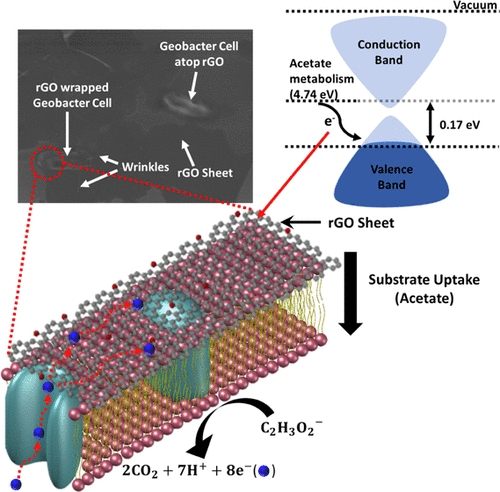当前位置:
X-MOL 学术
›
ACS Appl. Electron. Mater.
›
论文详情
Our official English website, www.x-mol.net, welcomes your
feedback! (Note: you will need to create a separate account there.)
Interface of Electrogenic Bacteria and Reduced Graphene Oxide: Energetics and Electron Transport
ACS Applied Electronic Materials ( IF 4.3 ) Pub Date : 2020-04-01 , DOI: 10.1021/acsaelm.0c00057 Sheldon Cotts 1 , Bijentimala Keisham 1 , Jay Rawal 1 , Vikas Berry 1
ACS Applied Electronic Materials ( IF 4.3 ) Pub Date : 2020-04-01 , DOI: 10.1021/acsaelm.0c00057 Sheldon Cotts 1 , Bijentimala Keisham 1 , Jay Rawal 1 , Vikas Berry 1
Affiliation

|
A synergistic, nanoscale electrical interface with the membranes of exoelectrogenic microbes will have a transformative impact on biological cell-based electronic devices. Here, we report that a conformal graphenic interface on a biocatalytic Geobacter sulfurreducens membrane results in quantum-capacitance-induced n-doping in reduced graphene oxide (rGO) that further enhances electron shuttling from the membrane to improve electron harvesting from the electrogenic organism. The quantum coupling of rGO with the connected protein-membrane channels leads to an additional electron density of 3.91 × 1012 cm–2 and an increase in the in-plane phonon vibration energies (G) of rGO by ∼5 cm–1. This n-doping enhances the electron-transfer rate from the cell membrane into the rGO via a net driving potential of 158 meV with a 3-fold increase in power density. The synergistic electron harvesting and conformal membrane interfacing of flexible two-dimensional (2D) nanomaterials can lead to an evolution in the design of microbe circuitry to power stand-alone nanodevices.
中文翻译:

电化学细菌和氧化石墨烯的界面:能量学和电子传输
与放生微生物膜的协同,纳米级电接口将对基于生物细胞的电子设备产生变革性影响。在这里,我们报道生物催化的Geobacter硫还原膜上的共形石墨烯界面在还原的氧化石墨烯(rGO)中导致了量子电容诱导的n掺杂,从而进一步增强了从膜的电子穿梭,从而改善了从成电生物体收集电子的过程。rGO与相连的蛋白膜通道的量子耦合导致了3.91×10 12 cm –2的附加电子密度,并使rGO的面内声子振动能(G)增加了约5 cm –1。这种n掺杂通过158 meV的净驱动电位提高了从细胞膜到rGO的电子转移速率,功率密度提高了3倍。柔性二维(2D)纳米材料的协同电子收集和共形膜接口可以导致为独立纳米设备供电的微生物电路设计的发展。
更新日期:2020-04-01
中文翻译:

电化学细菌和氧化石墨烯的界面:能量学和电子传输
与放生微生物膜的协同,纳米级电接口将对基于生物细胞的电子设备产生变革性影响。在这里,我们报道生物催化的Geobacter硫还原膜上的共形石墨烯界面在还原的氧化石墨烯(rGO)中导致了量子电容诱导的n掺杂,从而进一步增强了从膜的电子穿梭,从而改善了从成电生物体收集电子的过程。rGO与相连的蛋白膜通道的量子耦合导致了3.91×10 12 cm –2的附加电子密度,并使rGO的面内声子振动能(G)增加了约5 cm –1。这种n掺杂通过158 meV的净驱动电位提高了从细胞膜到rGO的电子转移速率,功率密度提高了3倍。柔性二维(2D)纳米材料的协同电子收集和共形膜接口可以导致为独立纳米设备供电的微生物电路设计的发展。











































 京公网安备 11010802027423号
京公网安备 11010802027423号